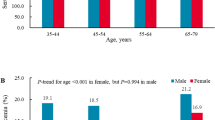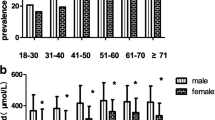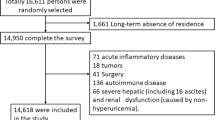Abstract
The increasing trend of hyperuricemia in urban areas of China has been noted in the past decade. However, the prevalence of hyperuricemia in rural China has not been extensively investigated. We aimed to estimate the prevalence and risk factors of hyperuricemia and the associated comorbidities in rural Northeast China. This survey was conducted from July 2012 to August 2013. In this study, a total of 11,576 residents from the rural Northeast China were randomly selected and examined. Hyperuricemia was defined as serum uric acid ≥416 μmol/l in men and ≥357 μmol/l in women. Data regarding the demographic and lifestyle characteristics and the blood biochemical indexes of these participants were collected by well-trained personnel. The prevalence of hyperuricemia was 10.9 % and was more prevalent in men than in women (15.0 vs. 7.3 %, P < 0.001). Multivariate logistic regression models revealed that besides age, hyperuricemia in men was associated with ethnic minority [OR (95 %): 0.683 (0.472,0.989)], physical activity [moderate, OR (95 %): 0.716 (0.596,0.859); high, OR (95 %): 0.527 (0.354,0.786)], current smoking [OR(95 %):1.380 (1.179,1.616)], and current drinking [OR(95 %):0.705 (0.603,0.825)], while in women was only associated with ethnic minority [OR(95 %):0.485 (0.262,0.896)]. After adjusting for possible confounders, hyperuricemia was related to different subtypes of cardiometabolic comorbidities in both gender like abdominal obesity, general obesity, hypertriglyceridemia, hypertension, hypercholesterolemia, and low HDL-C. Besides, in women only, hyperuricemia was related to diabetes and high LDL-C. Hyperuricemia was common among residents living in rural Northeast China especially among men. Ethnic minority, physical activity, current smoking, and drinking contributed to hyperuricemia in this population.



Similar content being viewed by others
References
Wallace KL, Riedel AA, Joseph-Ridge N, Wortmann R (2004) Increasing prevalence of gout and hyperuricemia over 10 years among older adults in a managed care population. J Rheumatol 31:1582–1587
Zheng ML, Lai YH, He XN, Tan FW (2008) Correlation of detection of hyperuricemia with hypertension in healthy population in Guangzhou City. China Trop Med 8:512–514
Choi HK, Atkinson K, Karlson EW, Willett W, Curhan G (2004) Purine-rich foods, dairy and protein intake, and the risk of gout in men. N Engl J Med 350:1093–1103
Choi HK, Atkinson K, Karlson EW, Willett W, Curhan G (2004) Alcohol intake and risk of incident gout in men: a prospective study. Lancet 363:1277–1281
Batis C, Sotres-Alvarez D, Gordon-Larsen P, Mendez MA, Adair L, Popkin B (2014) Longitudinal analysis of dietary patterns in Chinese adults from 1991 to 2009. Br J Nutr 111:1441–1451
Du S, Chen S-L, Wang Y, Xu LQ (1998) The epidemiological of hyperuricemia and gout in a community population of Huangpu district in Shanghai. Chin J Rheumatol 2:75–78
Tian XC, Jiang Z-CH, Bao G-CH, Gao WG, Nan HR, Wang SH-J (2008) Analysis on prevalence and influence factors of hyperuricemia among residents in Qingdao. Chin J Pubic Health 24:360–362
Han XH, Yao XY, Fang X-SH (2008) The prevalence of hyperuricemia and abnormal of lipid and glucose in medical examination population. Shanxi Med J 37:438–439
Cao YJ, Liu Y, Li T, Yan BS, Wang ZH-ZH, Yang XL (2010) Investigation of the increasing of policemen in blood uric acid and triglyceride in Haikou. Hainan Med J 21:120–121
Gustafsson D, Unwin R (2013) The pathophysiology of hyperuricaemia and its possible relationship to cardiovascular disease, morbidity and mortality. BMC Nephrol 14:164
Lu X, Li X, Zhao Y, Zheng Z, Guan S, Chan P (2014) Contemporary epidemiology of gout and hyperuricemia in community elderly in Beijing. Int J Rheum Dis 17:400–407
Villegas R, Xiang YB, Cai Q, Fazio S, Linton M, Li H (2010) Prevalence and determinants of hyperuricemia in middle-aged, urban Chinese men. Metab Syndr Relat Disord 8:263–270
O'Brien E, Petrie J, Littler W, de Swiet M, Padfield PL, O'Malley K (1990) The British hypertension society protocol for the evaluation of automated and semi-automated blood pressure measuring devices with special reference to ambulatory systems. J Hypertens 8:607–619
Feig DI, Johnson RJ (2003) Hyperuricemia in childhood primary hypertension. Hypertension 42:247–252
Chobanian AV, Bakris GL, Black HR, Cushman WC, Green LA, Izzo JL Jr (2003) The seventh report of the joint national committee on prevention, detection, evaluation, and treatment of high blood pressure: the JNC 7 report. JAMA 289:2560–2572
Hypertension control. Report of a WHO Expert Committee (1996) World Health Organ Tech Rep 862:1–83
WHO/FAO (2003) Expert consultation on diet, nutrition and the prevention of chronic diseases, report of the joint WHO/FAO expert consultation. World Health Organization, Geneva
Expert Panel on Detection, Evaluation, and Treatment of High Blood Cholesterol in Adults (2001) Executive summary of the third report of the National Cholesterol Education Program (NCEP) expert panel on detection, evaluation, and treatment of high blood cholesterol in adults (Adult Treatment Panel III). JAMA 285:2486–2497
World H, Wang CN, Liang Z, Wei P, Liu P, Yu JX, Zhang DM (2002) Changes in dietary patterns and certain nutrition-related diseases in urban and rural residents of Jiangsu Province, China, during the 1990s. Biomed Environ Sci 15:271–276
Health Organization and International Diabetes Fedaration (2006) Definition and diagnosis of diabetes mellitus and intermediate hyperglycemia: report of a WHO/IDF consultation. World Health Organization, Geneva
Hu G, Tuomilehto J, Silventoinen K, Barengo N, Jousilahti P (2004) Joint effects of physical activity, body mass index, waist circumference and waist-to-hip ratio with the risk of cardiovascular disease among middle-aged Finnish men and women. Eur Heart J 25:2212–2219
Panagiotakos DB, Pitsavos C, Chrysohoou C, Risvas G, Kontogianni MD, Zampelas A (2004) Epidemiology of overweight and obesity in a Greek adult population: the ATTICA study. Obes Res 12:1914–1920
Huang HB, Jin HW, Chen ZH-SH (2009) The analysis of hyperuricemia about medical examination population in Xiamen. Henan J Prev Med 20:345–347
Chen YQ (2008) The prevalence of hyperuricemia and related factors which is from urban population in Chongqing. J Third Mil Med Univ 30:1013–1014
Yang C, Liu G-ZH, Liu YX, Feng GJ (2009) Hyperuricemia in Tibetans undergoing health examination in Linzhi District in Tiebet. Mil Med J South China 23:10–12
Darmawan J, Valkenburg HA, Muirden KD, Wigley RD (1992) The epidemiology of gout and hyperuricemia in a rural population of Java. J Rheumatol 19:1595–1599
Lohsoonthorn V, Dhanamun B, Williams MA (2006) Prevalence of hyperuricemia and its relationship with metabolic syndrome in Thai adults receiving annual health exams. Arch Med Res 37:883–889
Qiu L, Cheng XQ, Wu J, Liu JT, Xu T, Ding HT, Liu YH, Ge ZM, Wang YJ, Han HJ, Liu J, Zhu GJ (2013) Prevalence of hyperuricemia and its related risk factors in healthy adults from Northern and Northeastern Chinese provinces. BMC Public Health 13:664
Tsai EC, Boyko EJ, Leonetti DL, Fujimoto WY (2000) Low serum testosterone level as a predictor of increased visceral fat in Japanese-American men. Int J Obes Relat Metab Disord 24:485–491
Liu L, Lou S, Xu K, Meng Z, Zhang Q, Song K (2013) Relationship between lifestyle choices and hyperuricemia in Chinese men and women. Clin Rheumatol 32:233–239
Antón FM, García Puig J, Ramos T, González P, Ordás J (1986) Sex differences in uric acid metabolism in adults: evidence for a lack of influence of estradiol-17 beta (E2) on the renal handling of urate. Metabolism 35:343–348
You L, Liu A, Wuyun G, Wu H, Wang P (2014) Prevalence of hyperuricemia and the relationship between serum uric acid and metabolic syndrome in the Asian Mongolian area. J Atheroscler Thromb 21:355–365
Munan L, Kelly A, PetitClerc C (1976) Population serum urate levels and their correlates. The Sherbrooke regional study. Am J Epidemiol 103:369–382
Janghorbani M, Amini M, Willett WC, Mehdi Gouya M, Delavari A, Alikhani S (2007) First nationwide survey of prevalence of overweight, underweight, and abdominal obesity in Iranian adults. Obesity 15:2797–2808
Qu YL, Yu L, Li ZM, Kong LH, Xiao TC, Li M (2013) Epidemiological status and risk factors of hyperuricemia in rural area of the Three Gorges. Zhonghua Xin Xue Guan Bing Za Zhi 4:427–431, Chinese
Nakamura K, Sakurai M, Miura K, Morikawa Y, Yoshita K, Ishizaki M (2012) Alcohol intake and the risk of hyperuricaemia: a 6-year prospective study in Japanese men. Nutr Metab Cardiovasc Dis 22:989–996
Wannamethee SG, Shaper AG, Alberti KG (2000) Physical activity, metabolic factors, and the incidence of coronary heart disease and type 2 diabetes. Arch Intern Med 160:2108–2116
Ka T, Yamamoto T, Moriwaki Y, Kaya M, Tsujita J, Takahashi S (2003) Effect of exercise and beer on the plasma concentration and urinary excretion of purine bases. J Rheumatol 30:1036–1042
Feig DI, Kang DH, Johnson RJ (2008) Uric acid and cardiovascular risk. N Engl J Med 359:1811–1821
Chelyabinsk M, Ambroszkiewicz J, Gajewska J, Laskowska-Klita T, Leibschang J (2007) The effect of tobacco smoking during pregnancy on concentration of uric acid in matchedmaternal cord pairs. Przegl Lek 64:667–670
Kosugi T, Nakagawa T, Kamath D, Johnson RJ (2009) Uric acid and hypertension: an age-related relationship? J Hum Hypertens 23:75–76
Lv Q, Meng XF, He FF, Chen S, Su H, Xiong J (2013) High serum uric acid and increased risk of type 2 diabetes: a systemic review and meta-analysis of prospective cohort studies. PLoS One 8:e56864
Wang SF, Shu L, Wang S, Wang XQ, Mu M, Hu CQ (2014) Gender difference in the association of hyperuricemia with hypertension in a middle-aged Chinese population. Blood Press 6:1–6
Mazzali M, Hughes J, Kim YG, Jefferson JA, Kang DH, Gordon KL (2001) Elevated uric acid increases blood pressure in the rat by a novel crystal-independent mechanism. Hypertension 38:1101–1106
Mazzali M, Kanellis J, Han L, Feng L, Xia YY, Chen Q (2002) Hyperuricemia induces a primary renal arteriolopathy in rats by a blood pressure-independent mechanism. Am J Physiol Ren Physiol 282:F991–F997
Kanellis J, Kang DH (2005) Uric acid as a mediator of endothelial dysfunction, inflammation, and vascular disease. Semin Nephrol 25:39–42
Acknowledgments
This study was supported by grants from the "Twelfth Five-Year" project funds (National Science and Technology Support Program of China, Grant # 2012BAJ18B02) and the Social Development Research Program of Liaoning Province (2013225089).
Disclosures
None.
Author information
Authors and Affiliations
Corresponding author
Rights and permissions
About this article
Cite this article
Yu, S., Yang, H., Guo, X. et al. Prevalence of hyperuricemia and its correlates in rural Northeast Chinese population: from lifestyle risk factors to metabolic comorbidities. Clin Rheumatol 35, 1207–1215 (2016). https://doi.org/10.1007/s10067-015-3051-6
Received:
Revised:
Accepted:
Published:
Issue Date:
DOI: https://doi.org/10.1007/s10067-015-3051-6




